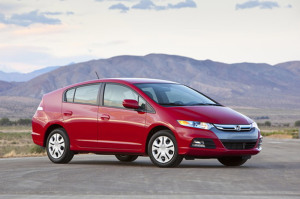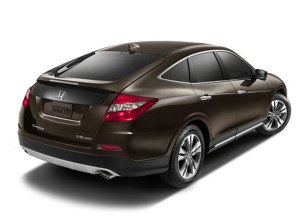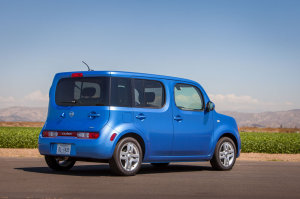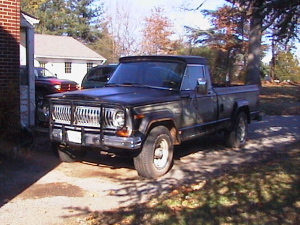Back in 2013, I said that the auto industry seemed to be recovering its collective sense of style. The major new introductions and redesigns for 2013 generally weren’t bad, and that remains true in 2014. That said, a lot of ugly cars are still on the market—mostly older designs that, like zombies, have carried-on long past their expiration date.
There are, however, a few changes this year. The Nissan Murano CrossCabriolet was excluded from the 2013 list because the 2012 model was still on sale and a new one had not been announced. We were hoping that meant it was discontinued, but no such luck . . . a 2013 version did eventually come out, and now a 2014 model as well, so it returns to the list. This results in the Kia Soul dropping off the end of the list. In addition, as my tastes evolve, I have shuffled the list’s order. Some designs start looking [slightly] better with time; some start looking worse.
The criteria for inclusion is the same it has always been. I don’t include models that aren’t sold in the United States. I don’t include models that sell in low volume (and volume is defined completely subjectively based on how many I see on the highways in the Washington, DC, metropolitan area). I don’t include exotic, military, or special-purpose vehicles—so no super-cars, tanks, or postal trucks. I also don’t include vehicles reserved exclusively for the commercial market, such as the repulsive Ram Promaster.
This is based entirely on my personal opinion of what looks good and what doesn’t. I encourage your comments—whether they be nominations of ugly cars I may have missed, or impassioned defenses of the ones I didn’t. And if you own one of the cars on this list, well, don’t take it personally.
The List
-
Toyota Prius

Toyota Prius Dropping to the tenth position—perilously close to falling off the list entirely—is the Toyota Prius. It’s still ugly, and still belongs on this list, but it has lost some of its ‘in your face’ repulsiveness . . . not because of any worth-while improvements to its design over the years, but because I have seen it so many thousands of times that I am becoming numb to it. This is the car that is meant for the pretentious brand of environmentalist, the ones who are more concerned about looking like they care about the planet than actually doing something useful for it. Yeah, it’s fuel efficient, but there are other hybrid options out there that drive better, have more options, and don’t look like a misshapen cheddar wedge. But they blend right in with everybody else, and that just wouldn’t do.
-
Honda Insight

Honda Insight The Honda Insight—a blatant rip-off of Toyota’s Prius—is making what will probably be its last appearance on this list. Honda has announced that it will be discontinued after the 2014 model year, and thank goodness for that. It isn’t really any uglier than the Prius, in my humble opinion, but rates worse in this list because of Honda’s lack of originality. Taking a photocopier to a Prius and slapping some different badges on it is something you would expect from one of the Chinese car companies—you know, the ones that take great pleasure in ripping-off Japanese and European designs and calling them their own. Honda is, or at least should be, better than that. The problem for Honda is that the pretentious environmentalists can’t buck the crowd and go for anything but an original, name-brand Prius . . . and the rest of the market wouldn’t drive either car if you gave it to them for free.
-
Toyota FJ Cruiser

Toyota FJ Cruiser The Toyota FJ Cruiser is also making what is probably its last appearance on the list, as Toyota has announced that it will be discontinued after the 2014 model year. In a certain sense, it’s a shame to see the FJ Cruiser go. After all, there are very few rugged utility vehicles left. After the FJ Cruiser is gone, the Jeep Wrangler and Nissan Xterra will be the only body-on-frame options left for those who don’t want a pickup and don’t want a giant gas-guzzler. The FJ Cruiser is a surprisingly capable off-roader, but it never had the rugged looks of the Wrangler or the less-rugged (but capable) looks of the Xterra. Most crossover and SUV buyers don’t care if their car can drive up a rocky mountain trail, but they still want it to look tough with some cladding and a bit of ground clearance. The FJ Cruiser seems to be marketed at some weird inverted version of that market, one where people want real 4×4 capability in a car that looks cute, plastic, and breakable.
-
Honda Crosstour

Honda Crosstour I would love to know what was happening in the room when the idea for the Honda Crosstour was developed. It is based on the Honda Accord sedan . . . in fact, it was originally branded as the Accord Crosstour. My guess is that the original idea was to bring back a wagon version of the Accord, but somebody said that Americans don’t like wagons anymore, so the designers gave it some more ground clearance and called it a crossover. Hey, it worked for Subaru. It did not, however, work for Honda. Instead of an Accord with the utility turned up, we got an Accord with the attractiveness turned down. And it just gets worse every time I see one, which is why it has gained a few positions on this list. If you want a crossover, just buy Honda’s own CR-V or one of its competitors. If you want a wagon, just buy one of the real wagon offerings from Subaru or Volvo or Volkswagen.
-
Honda CR-Z

Honda CR-Z The Honda CR-Z, like so many ugly cars, was born out of a misguided effort to bridge unrelated markets. The Prius is for environmentalists who don’t care about the environment. The Insight is for people who want a Prius but don’t want a Prius. The FJ Cruiser is for off-roaders who don’t want to look like they off-road. The Crosstour is for people who want a wagon but don’t want to admit they’re driving a wagon. And the CR-Z is meant for people who want a plodding enviro-car that is also a sports car. Look, people who want a sports car usually don’t care how fuel efficient it is. And people who are obsessed with fuel economy and looking like they’re saving the planet don’t usually care how a car drives. Like so many other hybrids, the CR-Z aims for such a strange, little corner of the market that it completely misses the chance to appeal to the masses . . . and the fact that it looks like it was glued together from the worst leftover parts in the Honda bin doesn’t help either.
-
Smart Fortwo

Smart Fortwo The Smart Fortwo is a tiny city car that is such a dumb idea that Daimler over-compensated by naming the entire brand ‘Smart.’ City-dwellers who need compact, park-anywhere transportation and aren’t concerned about performance, comfort, or looks can get a motor-scooter or motorcycle or golf cart for much less than the price of a Fortwo. Those who need a utilitarian econo-box for groceries, out-of-town trips, and toting their friends around can get bigger, more useful, and better looking subcompacts from Toyota, Scion, Honda, Nissan, Ford, and others starting at roughly the same price. And the Smart Fortwo is so incredibly goofy looking that I have a hard time stifling laughter every time I see one. If you want a car that is small for the sake of being small, don’t sacrifice your dignity . . . just buy a Mini Hardtop.
-
Mini Coupe

Mini Coupe The Mini Coupe is a real misfire from BMW’s otherwise-excellent Mini brand. One could argue that they have diluted the brand with unnecessary variants like the Roadster and the Paceman . . . but at least all of those variants have looked good, except for the Coupe. There is really no reason for the Coupe to exist in the first place. It is just a Hardtop with less room for groceries and no back seat (if you can really call the Hardtop’s back seat a back seat). But I could forgive it, if not for that absolutely horrific arrangement of the roof and the rear windows. I keep thinking that the Coupe will grow on me the more I see it . . . that some day it will make me smile like the rest of the Mini product line does . . . but so far, the opposite has been happening. Like so many other cars on this list, it seems like Mini just slapped this car together from their spare parts bin with little thought to how they would all look when assembled.
-
Nissan Juke

Nissan Juke I might have been too hard on the Nissan Juke when I gave it the top spot on this list last year. I mean, it isn’t hard to see why it might leap to the top of the pack with its frog-like front end, hockey-stick tail lights, and otherwise . . . weird appearance. But in the last year, as I have seen more and more of them on the roads, they have grown on me . . . a little. I can see why some might think it’s ‘cute,’ at least in that ‘so ugly it’s cute’ kind of way. So it still stays on the list, and near the top, but drops to third place. There are so many great options for a sub-compact crossover out there, it’s hard to understand why anybody would pick this one.
-
Nissan Murano CrossCabriolet

Nissan Murano CrossCabriolet Nissan has really been excelling in the ugly car realm lately, and the Nissan Murano CrossCabriolet is no exception. It is—no kidding—a two-door convertible version of the Murano crossover. Remember what I said about most ugly cars being directed at two completely unrelated markets? Try making a Venn diagram of buyers who want a large crossover and those who want a convertible and see if you find anybody in the overlap between. Nissan created a real mess of a car by trying to stick the shape of a convertible on the top of a crossover body, and then made it even worse by throwing in an Altima- or Maxima-inspired rear deck and tail lights. These ugly cars sure seem to make good use of the corporate parts bin! Thankfully, Nissan has already announced that 2014 will be the Murano CrossCabriolet’s final year blighting the showrooms.
-
Nissan Cube

Nissan Cube Nissan manages to take the three top spots in this year’s list, with the highest dishonors going to the Nissan Cube. From the front, it looks like one of those quirky sub-compact crossovers—cars like the Kia Soul or the Scion xB, which aren’t exactly lookers, but aren’t ‘top-ten’ ugly either. But then you look at it from the side . . . well, from the left side anyway, where it has those bug-eyed rounded windows. On the right side, however, it looks a bit better with the rear window wrapping around to the back. And then there’s the back . . . with the asymmetry of the vehicle on full display, the protruding duck-lip brake lights, the overall insanity of the thing. It looks like one of those nightmarish concept cars that somehow skipped the step where they turn it into something people might actually want to buy. And then they named this misshapen insult of a car for one of the most beautiful and symmetrical of all three-dimensional shapes: the cube. If you are thinking of buying one of these, don’t. Please. Just don’t.
Dishonorable Mention
-
Jeep Cherokee

Jeep Cherokee The new Jeep Cherokee is a really frustrating car. When photos first leaked, I thought for sure that it would find a place in my top ten list of ugly cars . . . but then the official announcement happened, I’ve seen a bunch on the road, and it’s really not bad. It looks pretty terrible from the front with those up-swept eyebrows and a lighting arrangement far too reminiscent of Nissan’s Juke, but from any other angle it looks like any other crossover. Coming up on one from behind, with a little bit of distance, you could easily mistake it for the Hyundai Santa Fe or any other practical, inoffensive family hauler. With a quick cosmetic refresh to the front end (and perhaps to some of the cladding on the rear), the Cherokee could be a fine mid-size crossover option.
Like its ancestor, the 1984-1996 Cherokee XJ, the new Cherokee manages to off-road with the best of ’em even though it is based on a unibody frame. It performs like a truck-based SUV, but drives day-to-day like a car-based crossover. This is a market niche that the Cherokee invented, and I applaud Fiat Chrysler Automobiles (FCA)—the merged descendant of Italy’s Fiat and the bankrupt, bailed-out hulk of Chrysler—for trying to keep it alive.
But FCA is aiming for the masses here, trying to gain share in the broad market of crossover and SUV buyers. I understand that. But I also understand that Jeep has always had a niche, and that niche is their greatest strength. Many Jeep customers keep coming back to Jeep because they are different than everything else. Jeep buyers want tough, functional vehicles that don’t blend in with the crowd. Previous efforts to break out of this mold—like the Compass and Patriot—have been disasters that hurt the brand more than they helped it. Even if the Cherokee does well, its success in the market could be a Pyrrhic victory for FCA. Jeep can break out of its niche, yes, and this might bring more sales in the short run . . . but once they’re out of their niche, they’re just one more crossover maker in a sea of crossovers. Their core market of Jeep fanatics will see their beloved brand turning to family haulers that look like Hyundais and, worse, cutesy lifestyle cars like the upcoming Renegade. They will start wondering why they should keep buying Jeeps when they aren’t much different from other, cheaper options.

Jeep J10 ‘Honcho’ Jeep’s future doesn’t hinge on reaching a mass market, but instead on playing to its strengths—toughness, simplicity, reliability, capability. Jeeps shouldn’t be pretty, and they sure as hell shouldn’t be cute. Jeep shouldn’t be selling crossovers, it should be selling the alternative to the crossover. With the FJ Cruiser leaving the market, the Xterra probably not far behind, and all the big SUV’s turning into glorified station wagons, the market for tough off-roaders—small, medium, and large—is Jeep’s for the taking and Jeep’s for the keeping. And they can easily get away with charging a (reasonable) premium over their competitors for the privilege of getting a real SUV instead of some grocerymobile.
Don’t compete with Hyundai and Toyota for the family hauler market, seize the woefully under-served market for people who want a serious SUV but can’t afford a Land Rover. Don’t fight with the crowd over some small slice of the huge market, but develop an impenetrable lock on your own little niche, and grow that niche incrementally. Bring back the pickups, drop the psuedo-Jeeps like the Compass, Patriot, and Renegade, and sell a full line of the toughest go-anywhere vehicles you can buy in the under-forty-thousand price range.
The Jeep Cherokee is the dishonorable mention this year, not just because of that horrible front-end styling, but because it—along with the upcoming Renegade—marks a turn in the wrong direction for one of America’s most venerable car companies. Jeep should be toughening back up from the brand-harming debacles of the DaimlerChrysler years, not trying to dilute the brand even further.
